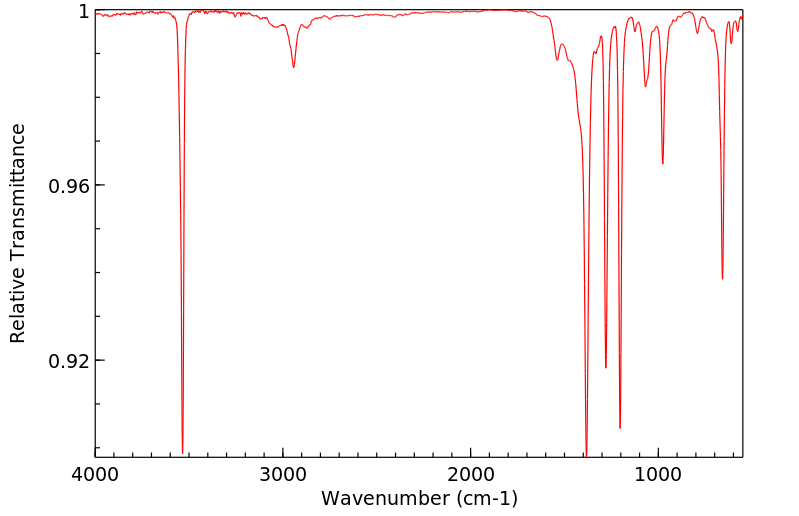2,4,6-三溴-3,5-二甲基苯酚 | 56759-60-5
中文名称
2,4,6-三溴-3,5-二甲基苯酚
中文别名
——
英文名称
2,4,6-tribromo-3,5-dimethylphenol
英文别名
2,4,6-Tribrom-3,5-dimethyl-phenol
CAS
56759-60-5
化学式
C8H7Br3O
mdl
——
分子量
358.855
InChiKey
OXUOISZCFYHEAT-UHFFFAOYSA-N
BEILSTEIN
——
EINECS
——
-
物化性质
-
计算性质
-
ADMET
-
安全信息
-
SDS
-
制备方法与用途
-
上下游信息
-
文献信息
-
表征谱图
-
同类化合物
-
相关功能分类
-
相关结构分类
计算性质
-
辛醇/水分配系数(LogP):4.4
-
重原子数:12
-
可旋转键数:0
-
环数:1.0
-
sp3杂化的碳原子比例:0.25
-
拓扑面积:20.2
-
氢给体数:1
-
氢受体数:1
安全信息
-
海关编码:2908199090
SDS
反应信息
-
作为反应物:描述:参考文献:名称:Brittain, Judith M.; Calvert, David J.; Mare, Peter B.D. de la, Journal of the Chemical Society. Perkin transactions II, 1984, p. 2005 - 2012摘要:DOI:
-
作为产物:描述:3,5-二甲基-2-环己烯-1-酮 在 ammonium metavanadate 、 四丁基溴化铵 、 氧气 、 三氟乙酸 作用下, 以 1,4-二氧六环 为溶剂, 反应 72.0h, 以73%的产率得到2,4,6-三溴-3,5-二甲基苯酚参考文献:名称:分子氧下钒催化2-环己烯酮的氧化芳构化摘要:通过将市售廉价的不含配体的钒催化剂,溴化物源和酸在大气压下组合使用,可以实现2-环己烯酮的有效催化氧化芳构化,从而得到相应的苯酚衍生物。该催化氧化芳构化甚至在空气中也进行。此外,成功进行了克级反应。DOI:10.1016/j.tetlet.2009.10.070
文献信息
-
Electrochemical Method for the Preparation of Dibromomethyl, Bis(bromomethyl), and Bis(dibromomethyl) Arenes作者:K. Kulangiappar、G. Karthik、M. Anbu KulandainathanDOI:10.1080/00397910802654757日期:2009.6.9Electrochemical bromination of alkyl aromatic compounds by two-phase electrolysis yields the corresponding α, α-dibrominated products. The reaction has been carried out in a single-compartment electrochemical cell using aqueous sodium bromide (40–50%), containing a catalytic amount of HBr as electrolyte, and chloroform, containing an alkyl aromatic compound, as the organic phase with a Pt plate as anode at 10–15°C
-
Phase-Vanishing Methodology for Efficient Bromination, Alkylation, Epoxidation, and Oxidation Reactions of Organic Substrates作者:Nirmal K. Jana、John G. VerkadeDOI:10.1021/ol035391b日期:2003.10.1to the U-tube method is to employ a solvent with greater density than the fluorous phase, such as 1,2-dibromoethane. This modification has been successfully applied to the methylation of a phenol derivative with dimethyl sulfate and to the m-CPBA-induced epoxidation of alkenes, N-oxide formation from nitrogen-containing compounds, and S-oxide or sulfone formation from organic sulfides.
-
Benzyne 1,2,4-Trisubstitution and Dearomative 1,2,4-Trifunctionalization作者:Jiarong Shi、Lianggui Li、Chunhui Shan、Zhonghong Chen、Liang Dai、Min Tan、Yu Lan、Yang LiDOI:10.1021/jacs.1c04389日期:2021.7.214-trifunctionalization of benzyne have been accomplished from sulfoxides bearing a penta-2,4-dien-1-yl moiety. These cascade transformations proceed through a benzyne insertion into the S═O bond and an uncommon regiospecific anionic [4,5]-sigmatropic rearrangement, furnishing a C–O, C–S, and C–C bond on the C1-, C2-, and C4-position of a benzene ring, respectively. This study showcases new cascade benzyne reaction苄的 1,2,4-三取代和脱芳基 1,2,4-三官能化均由带有五-2,4-二烯-1-基部分的亚砜完成。这些级联转化通过苯炔插入 S=O 键和不常见的区域特异性阴离子 [4,5]-σ 重排进行,在 C1-、C2- 上提供 C-O、C-S 和 C-C 键, 和苯环的 C4 位,分别。该研究展示了新的级联苯炔反应模式,包括远端 C-H 键功能化和脱芳构化。
-
Nuclear Versus Side-Chain Bromination of 4-Methoxy Toluene by an Electrochemical Method作者:K. Kulangiappar、M. Anbukulandainathan、T. RajuDOI:10.1080/00397911.2014.905599日期:2014.9.2Abstract The electrochemical bromination of 4-methoxy toluene by two-phase electrolysis yields 3-bromo 4-methoxy toluene at first, which subsequently undergoes side-chain bromination to give 3-bromo 4-methoxy benzyl bromide as a final product in 86% yield. The two-phase electrolysis consists of 25–50% NaBr as aqueous electrolyte and CHCl3 containing aromatic compound as organic phase. The reaction
-
Halogenation Using Quaternary Ammonium Polyhalides. XX. Bromination of Phenols with Polymer-Bound Benzyltrimethylammonium Tribromide作者:Takaaki Kakinami、Hiroyuki Suenaga、Tadashi Yamaguchi、Tsuyoshi Okamoto、Shoji KajigaeshiDOI:10.1246/bcsj.62.3373日期:1989.10Bromo-substituted phenols were obtained quantitatively by passing a solution of phenols in dichloromethane–methanol through a column packed with styrene polymer-bound benzyltrimethylammonium tribromide.
表征谱图
-
氢谱1HNMR
-
质谱MS
-
碳谱13CNMR
-
红外IR
-
拉曼Raman
-
峰位数据
-
峰位匹配
-
表征信息
同类化合物
(2-氯-6-羟基苯基)硼酸
黄柄曲菌素
高香草酸-d3
高香草酸-13C6
高香草酸
高香兰酸乙酯
高辣椒素II
高二氢辣椒素I
香草醛醛肟
香草醛苯腙
香草醛-甲氧基-13C
香草醛-(N-对甲苯基肟)
香草醛
香草酸肼
香草壬酰胺
香草基扁桃酸乙酯
香草吗啉
香草二乙胺
香兰素胺硬脂酸盐
香兰素胺硬脂酸盐
香兰素胺盐酸盐
香兰素丙二醇缩醛
香兰素13C6
香兰素-D3
香兰基乙基醚
香兰基丁醚
顺式-5-正十五碳-8'-烯基间苯二酚
顺式-1-(2-羟基-5-甲基苯基)-2-丁烯-1-酮
顺式-1-(2-羟基-4-甲氧基苯基)-2-丁烯-1-酮
顺-3-氯二氢-5-苯基呋喃-2(3H)-酮
雌二醇杂质1
降二氢辣椒碱
阿诺洛尔
阿瓦醇
阿普斯特杂质
间苯二酚双(二苯基磷酸酯)
间苯二酚-烯丙醇聚合物
间苯二酚-D6
间苯二酚
间苯三酚甲醛
间苯三酚二水合物
间苯三酚
间羟基苯乙基溴
间硝基苯酚
间甲酚紫钠盐
间甲酚与对甲酚和苯酚甲醛树脂的聚合物
间甲酚-D7
间甲酚-D3
间甲酚
间溴苯酚







